The Royals Have the Mike Trout Scouting Report
How to pitch to the best player in baseball.
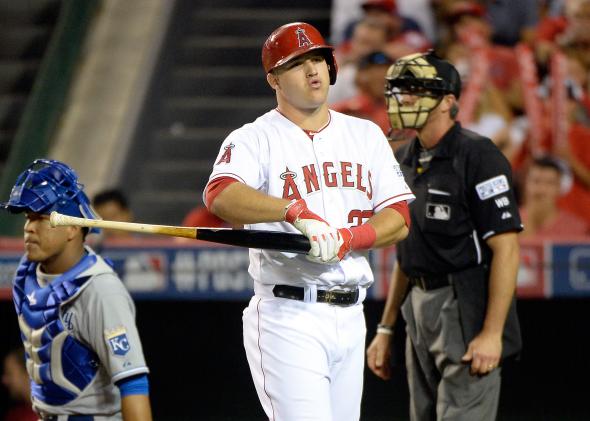
Photo by Harry How/Getty Images
Pitch Mike Trout high and hard. You might damn well be sick of reading about this. I couldn’t even blame you, but you have to understand the nugget that we’re sitting on, here. It’s unusual that we know about such a stark vulnerability. It also happens to belong to the best player in baseball, a player we’ve written so many thousands of words about here before, and that player is in the playoffs now, looking to lead his team to a World Series. Pitch Mike Trout high and hard. The report’s been known for months, but to me it’s still endlessly fascinating to see how pitchers and teams make use of the information. This trend is pretty clear—the table below shows Trout’s month-by-month rates of high fastballs seen:
| Month | High FA% | MLB Rank |
|---|---|---|
| April | 29.6% | 118 |
| May | 34.7% | 11 |
| June | 34.9% | 10 |
| July | 39.2% | 3 |
| August | 43.3% | 1 |
| September | 41.1% | 2 |
If we’ve been able to identify something, you’d better believe Major League Baseball has been able to identify that something, so Trout in the second half saw more high fastballs than anybody else, by a few percentage points. And what happened? Well, Trout remained pretty great, but after leading baseball in the first half with a 186 wRC+, second-half Trout dropped to 141, even with José Altuve. His walks went down and his strikeouts went up, and while he was seeing about 41 percent high fastballs, that means he was seeing 59 percent non-high-fastballs. That’s where Trout feasted. He’s going to win the league MVP, and he deserves it.
Thursday night, Trout played in the playoffs, as the Angels and Royals kicked off their ALDS. Starting for Kansas City was Jason Vargas, and that raised an interesting question. All right, pitch Trout high and hard. But what if you don’t have good high, hard stuff? What if you’re, say, Jason Vargas? One wondered how the Royals would approach Trout, and, now that we look back, the Royals approached Trout like the numbers say you should approach Trout. I have to note that Sam Miller has already written about this, very well, but he cheated by writing at night like some kind of hard and disciplined worker. It’s like, work during work hours, right? Let’s pretend like Miller didn’t beat me to the punch, and review Trout’s five trips to the plate. He finished 0 for 4 with a walk, by the way. The Royals won!
Plate Apperance No. 1, Bottom 1st
One can examine plate appearances by pitch results, or one can examine them by pitch intentions. I’ve decided to screenshot Salvador Pérez‘s pitch targets, which go left to right, like words do. Jason Vargas and Mike Trout for the first time (in October):
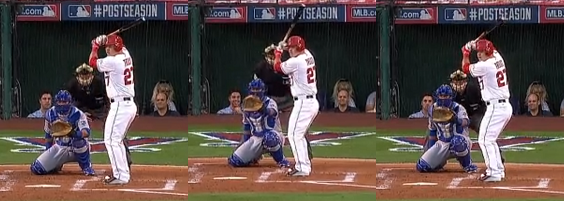
- Fastball
- Fastball
- Fastball
Perez wanted the first pitch more or less down the middle, a little in. And that absolutely seems dangerous, and perhaps that absolutely was dangerous, but Trout so infrequently swings at the first pitch of an at-bat, and he very infrequently swings at the first pitch he sees in a game. So Vargas got away with a called strike, then Perez called for consecutive high fastballs. The second one missed, lower and well inside, brushing Trout back. But Perez called for the same thing again, and Vargas executed. Trout lifted a shallow fly to left-center, though his swing looked good. His swing always looks good, but there are areas where it doesn’t seem to play.
PA No. 2, Bottom 4th
Leading off, it’s Trout against Vargas again:

- Fastball
- Fastball
- Fastball
- Fastball
Perez basically called for the same thing every time, and you’ll recognize those pitches as being high fastballs. Understand that, while Perez’s target is around Trout’s belt, for one thing the pitch will be higher than that at the front of the plate, and for another, Trout bends down some when he starts to swing, so his belt is lower than this. Vargas executed three of the pitches well. With the second one, he again missed down and well inside off the plate, but he came back with two fastballs high and tight, and Trout popped out to second. Think on how you feel about Mike Trout vs. Jason Vargas. Trout with the platoon advantage, against a soft-throwing change-up specialist? Feels like that should result in murder, right? At least statistical murder? Vargas was in charge. It’s weird.
PA No. 3, Bottom 6th
A lot of people felt like Vargas shouldn’t have been left in for the sixth inning, against the heart of the Angels’ order. But Vargas did face Trout for a third time, and here is that:

Sorry for the stupid fourth image but playoff baseball likes to experiment with stupid unhelpful camera angles. It looks like that fourth image shows Perez calling for a pitch up. Oh, right, I forgot to show the sequence:
- Curveball
- Fastball
- Fastball
- Fastball
There’s a change of pace—a first-pitch breaking ball, down, where breaking balls go. The idea, presumably, was to pre-emptively counter Trout’s idea of maybe looking to be aggressive. Ultimately it didn’t matter; Trout took the pitch, which was a curveball that flew away and missed the zone up. So then Perez called for a fastball, a little lower than previous fastballs, but also a little more inside, to try to tie Trout up. Vargas got a perfect called strike on the edge, then came back with the exact same pitch, this time called a ball. Perez wanted that one a little more up. Finally, the last pitch. It looks like Perez wanted a fastball up and in. Vargas certainly threw a fastball up and in. Trout flied out, somewhat harmlessly. So ended Trout vs. Vargas, with Vargas winning all three battles.
To review the three plate appearances: 10 of Vargas’ 11 pitches to Trout were fastballs. Of his other 69 pitches, 39 were fastballs. On the year, against righties, Vargas threw 54 percent fastballs. In the game, Vargas wound up throwing 19 high fastballs, eight of which were to Trout. So, eight of 11 pitches to Trout were high fastballs, with another intended to be a high fastball. Of his other 69 pitches, 11 were high fastballs. On the year, 44 percent of Vargas’ fastballs to righties were high. This is pretty clear evidence that Vargas and Perez had a particular plan to retire the AL MVP.
PA No. 4, Bottom 8th
Now for a completely different look. In his fourth time up, Trout had the distinct misfortune of having to deal with Wade Davis. Vargas is a soft-throwing lefty, and Davis is a hard-throwing righty. Against Davis, this season, righties batted .111, and they slugged .128, with 10 times as many strikeouts as walks. Trout walked! Victory! But, we care about the sequence, not the result. Said sequence, this time occupying two lines, left to right and top to bottom:
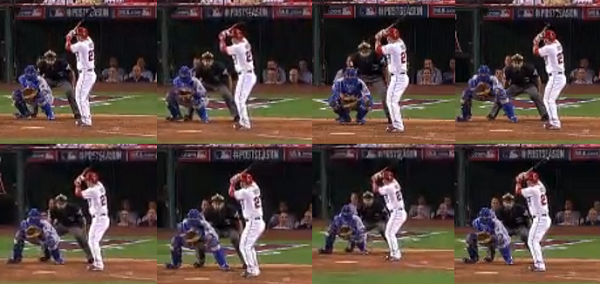
- Fastball
- Fastball
- Curveball
- Cutter
- Fastball
- Cutter
- Fastball
- Fastball
Totally different, at least in intent. Not once did Perez set up for a high fastball in or over the plate. As it happened, Davis wasn’t all that sharp, but Perez kept calling for heat on or beyond the outer edge, which is where Davis has lived all year against righties, with obviously spectacular success. The theory is probably this: With a guy like Vargas, it’s worth pitching to Trout’s weakness, because Vargas’ strength isn’t strong enough. With a guy like Davis, he’s so amazing and unhittable that he has the advantage even against the league’s best all-around player. It’s not like anyone can do much damage to a well-located Wade Davis fastball on the outside edge. Davis didn’t get to his statistics by accident.
The way the plate appearance played out, Davis actually threw a bunch of high fastballs. So maybe that was on purpose, but I think Davis was just wild. He threw just 15 of 27 pitches for strikes, and he opened the eighth by walking Chris Iannetta. Anyhow, the first fastball was supposed to be away, but it was actually up, and Trout swung! And missed. The second fastball was more on target, away and a little bit elevated, and Trout swung! And missed. The 0-and-2 pitch was a breaking ball—at 90 miles per hour—and while it looks like Perez is setting up on the lower edge, like a moron, what you miss in the screenshot is that Perez indicated he wanted the pitch really down, perhaps in the dirt. Davis spiked it. The next fastball missed the zone, up. The next one missed up, over the plate. The next pitch missed in and Trout fouled it off with a good cut. Then Trout fouled one more fastball before taking the last one, which was too high and a bit in. It was a difficult walk for Trout, and he got a lot of high heat, even though the plan was for Davis to bust him with heat away and lower than he saw.
PA No. 5, Bottom 10th
This time, the left-handed Danny Duffy, who some figured the Royals wanted to avoid. The leadoff hitter had reached; a double and the game was over. The plan:

- Fastball
- Fastball
- Fastball
The first fastball wasn’t supposed to be particularly high, but it was supposed to hug the inside edge. If executed, Trout would probably lay off and take a called strike. Duffy threw a good fastball, but it missed a few inches in, so he fell behind 1 and 0. The next signal looks familiar: heat, inside, near the belt. Foul ball. And the third signal is even more obvious: heat, a bit further up. Signals for two high fastballs from the lefty, and Trout grounded into a force. Thus, he went hitless in five trips, reaching once, and the Royals pulled it out on a home run from a considerably worse baseball player.
Funny thing about the Duffy/Trout showdown, though. And this helps to explain why Trout still hit so well in the second half despite all the high fastballs. Here’s the 1-and-0 fastball:
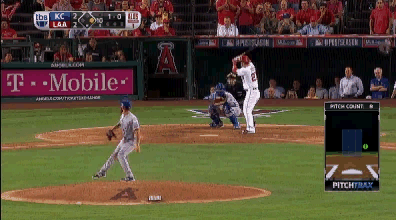
Duffy missed his target, and inadvertently threw a fastball basically in Trout’s sweet spot, with Trout ahead in the count. Trout barely missed the pitch. The next pitch:
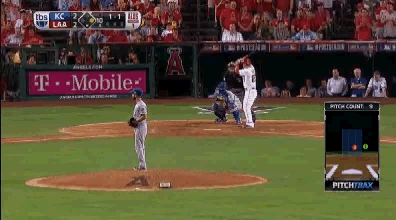
Similar kind of thing. Signal’s for a fastball up. Duffy threw a fastball down, at the same elevation as the previous fastball, the only difference being this one was a little more inside. Because it was on the edge, Trout wasn’t quite able to slam the pitch toward the wall, but this is a pitch Trout’s hammered before, and it’s a pitch he’ll hammer again. Twice in a row, Perez called for a fastball in Trout’s cold zone. Twice in a row, with the game on the line, Duffy threw a fastball in Trout’s hot zone, and though he survived, this is the thing: Even with a perfect plan, pitchers aren’t perfect. With pitchers knowing what to do against Mike Trout in the season’s second half, he hit 41 percent better than average, because some pitchers are too stubborn and some other pitchers make too many mistakes. The Royals know exactly how to get Mike Trout out. Doesn’t mean they’re always going to succeed. Doesn’t mean he’s not going to have an awesome series. Even if Trout doesn’t adjust, he’s going to get pitches where he wants them, because sometimes a pitcher just can’t help it.
So the good news for the Angels is pitchers make mistakes. The other good news is their whole lineup’s strong, so it’s no like it’s Mike Trout supported by ghosts. They should still score runs. But, against the best player in baseball in Game 1, the Royals weren’t afraid to attack, even with a fastball like Jason Vargas’. Yordano Ventura‘s fastball plays up. Even Jeremy Guthrie‘s fastball plays up. In a weird way, Trout’s most favorable matchup might be his matchup with the Royals’ best starting pitcher. But, who’s to say James Shields pitches Mike Trout like James Shields? Maybe he’ll pitch him like Jason Vargas. And then what?